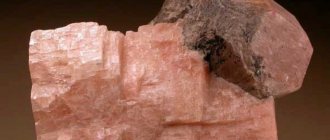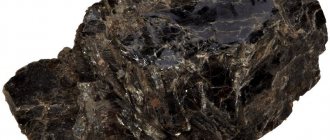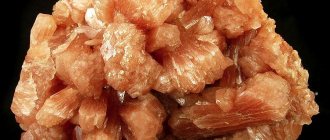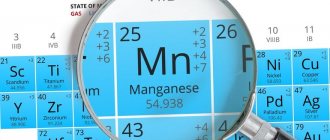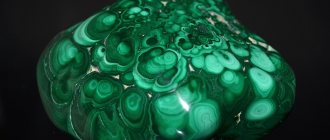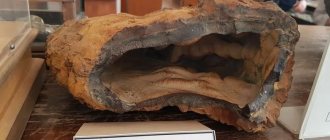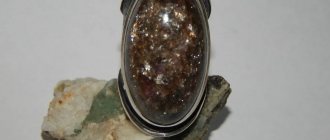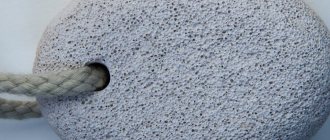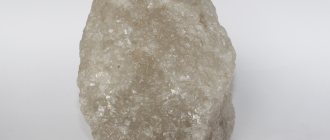Magnesium-ferruginous common hornblende
Magnesian-ferruginous common hornblende includes all hornblende with AlVI 0.85-1.5 and (Fe2+ + Fe3+) 1-2.5. They are members of an isomorphic series in which (Na + K)A varies from 0 to the maximum possible, equal to 1. At low contents of (Na + K)A, their composition is dominated by the chermakite type of heterovalent substitutions (ferrochermakitic common hornblendes - ferrotschermakitic common hornblendes) , at high contents of (Na + K)A - edenitic type of replacement (edenitic common hornblendes).
Synonyms: Uralite—- uralite; edenite—edenite.
Large crystals
What is
The term “hornblende” refers to a collection of minerals. They are united by belonging to the group of amphiboles (a class of silicates) and being rich in calcium.
In nature, it is a component of diabases, basalts, granites, and other rocks.
Igneous origin makes the stone durable. But wind and thermal springs transform it into quartz, chlorite, calcite or clay.
Chemical composition
The composition of magnesium-ferruginous common hornblende, taking into account isomorphic substitutions, is expressed by the formula: (Na, K)o-1[(Ca, Mn, Mg)2-1.34 Na0-0.66(Mg, Mn, Al, Ti)4 -2.5(Fe2+, Fe3+ )1-2.5] [(Si7.15-6.5o Al 0.85-1.5o) (O, OH)22] (OH, F, Cl, O)2 . The CaO content is usually in the range of 9-12.5%, the amount of Ca in the M(4) position rarely reaches the theoretical value, i.e. 2.00 per formula unit due to its partial replacement by Na, Mn, Fe2+, Mg. M(4) contains up to Na0.5o. There is no correlation with the content of Na and K at position A. The number of divalent cations Mn, Fe and Mg in the M(4) position is rarely more than 0.30 per formula unit. The most noticeable decrease in Ca content due to this replacement is in hornblende from eclogites and cummingtonite-bearing rocks. MgO content is from 7 to 18%, more often 9-15%. Conventional limits for Fe content are from 1 to 2.5 per formula unit. FeO - from 5.5 to 18.5%, Fe2O3 - from 0.5 to 7.5%; the proportion of Fe3+ is usually small, rarely up to 50%. Mn is almost always present in small quantities, usually up to 0.8% MnO (Mn0-0.10)> sometimes increases to 1-1.3%. The alkali content in magnesium-ferruginous common hornblende varies within the following limits: Na2O—0.50–3.40 (Na0.15–1.20); K2O 0.05-2.70% (Ko.o1-o.5o)
Hornblende without alkalis does not form under natural conditions, with a content of (Na + K) <0.50 they are rare, as well as with the highest contents of (Na + K). With a reduced Ca content, the upper limit of the (Na + K) content rises to 1.30 per formula unit. Na almost always significantly predominates over K. In hornblende associated with holmkvistite, 0.09-0.18% Li2O (Li0.05-0.10) was noted. Ti, like Mn, is present in almost all analyzed samples, usually up to 2% TiO2 (Ti 0.2o) - Increased (2-3.5%1 TiO2 content (Ti up to 0.40) is characteristic of common hornblende, forming phenocrysts in effusive rocks, but was also noted in hornblende of metamorphic rocks. Al2O3 content from 4.5 to 14.5% (AlVI 0-1), rarely slightly more. SiO2 content - 44-50%. F - up to 0.5-0.8%, often absent. A high F content was found in hornblende from the endocontact of a pegmatite vein (2.88%) and in hornblende from granodiorites (1.23%). Cl is rarely determined (0.03- 0.10%); in common hornblende from metasomatites of iron ore deposits - 0.24-0.35%. H2O+ from 0.5 to 3.5%. Low H2O+ contents are characteristic of edenite hornblende, in which OH groups are often replaced oxygen. Increased H2O+ content (replacement of the O radical with OH") in some common hornblende from granodiorites, from epidote amphibolites and from metasomatically altered rocks.
Varieties 1. Common hornblende - dark green in color. 2. Basaltic hornblende - black or brown.
Where can I meet
Large stones are very rare. Therefore, collectors from all over the world are willing to pay big money for such specimens. Quite large stones up to 0.5 m long were found in the Urals. Similar specimens can also be found in the Czech Republic and Italy.
The largest deposit is located in Germany. The Meissen massif and Burma are the main places where this mineral is mined. Geologists often find interesting rocks near dormant volcanoes.
Under the influence of water and wind, such specimens acquire an interesting shape and composition. These stones are especially valuable among collectors.
Physical properties
Optical
- The color is from light to dark green and almost black, sometimes with a blue or brown tint, less often brown.
- The streak is greenish-white, gray-green, brownish-green.
- Shine strong glass
- Transparency. Transparent or translucent in thin chips.
Mechanical
- Hardness 5.5 - 6
- Density 3.07—3.30
- The cleavage is perfect along (110) (at an angle of ~56°), sometimes separate along (100) and (101).
- The fracture is splintered, stepped.
- After compression along the c axis, sliding was observed with the formation of deformation twins along (100); with increasing temperature, twinning along (001) and (101) occurs.
Other properties
Heating behavior. When heated in the temperature range 550-900° in the air atmosphere, a gradual change in the optical properties of hornblende occurs: the green color of Ng gradually changes to brown-green, brown and red-brown, the refractive index increases sharply to approximately 1.750, birefringence - to 0.050, the angle cNg decreases to 0°, the density increases, the size of the unit cell decreases (common hornblende turns into basaltic). In this case, no clear effects are observed on the DTA curve. The change in properties upon heating is associated with the oxidation of divalent iron. When oxidized hornblende is heated in a stream of hydrogen, the green color and all other properties are restored. In the range of 1000-1100° there is an endothermic deflection on the DTA curves, caused by the intense release of water with solid-phase transformation into a cryptocrystalline aggregate of augite and maghemite. The shape of the fragments and grains is preserved. In a vacuum, iron oxidation does not occur; all water is released in the form of H2O molecules with simultaneous destruction of the structure. The decomposition products melt at 1150-1220° (depending on the content of alkali metals). The activation energy of dehydration is 46 kcal/mol, the activation energy of oxidation is 20 kcal/mol.
Diagnostic signs
In aggregates they are almost indistinguishable from hypersthene in color, features and hardness. External differences lie in the shape of the crystals (elongated, elongated prisms), shine (in hornblende it is much stronger), more perfect cleavage and the relative position of its planes (angle 124 and 56 degrees). To distinguish it from other amphiboles, special diagnostic methods are needed.
Associated minerals. Quartz, oligoclase, albite, magnetite, ilmenite, biotite, epidote, nepheline.
Scope of application
Due to its special property - fragility, despite the high hardness levels, reaching up to 5-6 units on the Mohs scale, the mineral group has not been widely used by jewelers. During processing, the rock breaks easily, so it is rarely used in jewelry making. It is very difficult to handle and due care must be taken while wearing it. Therefore, mineral stone is often not used in its pure form, but is only a source for obtaining precious and semi-precious stones from it.
It is possible to use mineral rock in the manufacture of jewelry when it is enclosed in a quartz base, which is quite common in nature. Hard and durable quartz is easy to process, and its shine emphasizes the existing internal inclusions with hornblende.
The chemical composition of the mineral hornblende makes it possible to lose or acquire new elements. Transformed under the influence of specific technological processes into calcite or quartz, capable of forming opals and carbonates upon decomposition, it acts as a raw material for the smelting of dark green glass and is part of granite in the construction industry. Green glass can be found in stained glass and as containers for drinks.
Hornblende is most widespread in industry. Bottles made of dark glass, smelted using hornblende, have been known since the times of the Soviet Union.
Other areas where hornblende is used include collecting. Occasionally found individual large-sized specimens may be of some value for museums and private home collections. Individual crystals of hornblende are of particular value; they can be obtained much less often than obtaining fine-crystalline masses that look like volcanic ones. Such masses, which resemble boulders in description, are considered industrial designs.
Hornblende is often used as a base for craft production in the manufacture of imitation gemstones.
Origin and location
Igneous - are rock-forming minerals of intermediate (diorites) and acidic (granites) intrusive rocks. Metamorphic - rock-forming mineral of hornblende schists, gneisses and amphibolites. Less commonly, skarn and pegmatite.
Magnesium-ferruginous common hornblende is widespread in nature. In igneous complexes they are observed mainly in rocks of intermediate composition: diorites, quartz diorites, granodiorites, and sometimes in the late magmatic stage they form in gabbro. They form phenocrysts in some effusive rocks of basic and intermediate composition. Of the metamorphic rocks, the most typical are plagioclase and epidote amphibolites; they are found in cummingtonite, garnet and pyroxene amphibolites and gneisses. In metasomatic rocks: rare. In gabbros and norites, igneous common hornblende is relatively rare and is more often postmagmatic. Igneous common hornblende gabbro is distinguished by brown tones of pleochroism, sometimes composing outer zones on sediments of earlier high-alumina hornblende or pyroxene. During the stage of autometamorphic uralitization, when pyroxenes are replaced by actinolite, brown magmatic hornblende remains stable, but under conditions of progressive metamorphism it is easily replaced by green with a lower Ti content, sometimes with the formation of zoned crystals. Examples: hybrid coarse-grained hornblende gabbro from Ospinsky char (Eastern Sayan); poikilitic pyroxene-hornblende gabbro of the Bohemian Massif (Czech Republic); hornblende gabbro of the Zhelezkovsky pluton in the Strandja anticlinorium (Bulgaria); granogabbro of Hornsund (Western Spitsbergen); gabbro of the Guadalupe plutonic complex in California (USA); Hornblende and pyroxene-hornblende gabbro of the Kitakami Mountains in Japan. The hornblende of the alkaline gabbro in Ichinoi (Northern Japan) may be of igneous origin.
The development of amphibolization causes a gradual transition from unaltered gabbro and norites to metagabbro, gabbro-amphibolites and amphibolites, sometimes observed within the same massif. Replacement is primarily carried out by pyroxene, and less commonly by plagioclase, sometimes with the formation of monmineral hornblendites. Examples of gabbros with hornblende, which partially or completely replaced pyroxenes: gabbro-amphibolites of the Urushten complex in the Caucasus, gabbro-anorthosites of the Anabar shield in Eastern Siberia, metagabbro-anorthosites of the northeastern part of the Kola Peninsula, gabbro of the Fay complex in Scotland, amphibolized gabbro in states of Delaware, Pennsylvania and California (USA), gabbroic rocks of the Hidaka metamorphic belt, Hokkaido (Japan), apogabbroic amphibolites of Urundi in Central Africa. In the Nyut-Ulbei massif in the area between the Ulbeya and Ini rivers (Priokhotye), an ordinary variety of the mineral forms metasomatic veins in gabbro-norite bodies. In areas of development of alkaline metasomatism in gabbroids, nest-shaped accumulations of edenite common hornblende are known, an example is the region of the Khaileol iron ore deposit in Khakassia. Common hornblende composes some hornblendites, the length of its crystals is up to 25 cm; pyroxene, magnetite, and sometimes cummingtonite (ingrowths) are associated with it as minor minerals. Hornblende hornblendites are characterized by relatively low iron content. Hornblendites, consisting of common hornblende, are known, for example, in the peridotite-gabbro-granediorite complex of New Caledonia, in the area of the Stewart batholith in the Cascade Mountains, pcs. Washington (USA), in northern Ticino (Switzerland), in Seville (Spain). Found in pyroxenites in the area of the Mariupol iron ore deposit in the Azov region (Ukraine) and in Kagura, Mount Kitakami (Japan). In diabases, dolerites and basalts, igneous common hornblende is rare, its color is brown, and it is characterized by a high content of titanium and iron (Fe>1.70). Recorded in the Budtinger diabases, New South Wales (Australia), in poorly differentiated sills, stocks and dikes of quartz diabases and gabbro-diabases of the Hasan-Grodekov fold zone in Primorye, in a dolerite dike in Western Bohemia (Czech Republic). In the process of regional metamorphism, it develops along pyroxene, an example is the diabase of the Chertomlyk-Solenovsky region of Ukraine. The intensive development of amphibolization of diabases leads to the formation of apodiabase amphibolites, for example, in the river basin. Ros (Ukraine). In Bidwell Bar, California (USA), the formation of ordinary tschermakite hornblende in diabases occurred in the contact aureole of a granitoid intrusion: in the outer part of the aureole it contains Fe 2.13. associated with oligoclase and epidote; in the inner part of the aureole contains less iron (Fe1.77) and coexists with more basic plagioclase, pyroxene and titanite. Near the contact with granites, it is found in diabases of the ophiolite formation of the Verkhovtsevsky synclinorium in Ukraine, and in basalts near the contact with adamellites in New South Wales (Australia). In the spilitic province of north-eastern Finland, coarse-grained hornblende-albite rock with relict pyroxene, titanite and apatite is developed in the core of a diabase sill; in the Winnetaba metaporphyry, Ghana, common hornblende is associated with albite, epidote, and ilmenite.
In diorites, quartz diorites, granodiorites and rocks similar in composition, common hornblende is often the main dark-colored component. Crystallized after pyroxene and plagioclase, but before biotite and K-feldspar. Partly it is in a reactionary relationship with these minerals: it replaces pyroxene and is itself replaced by biotite and K-feldspar. In rocks of intermediate composition with common hornblende, quartz is common. The presence of common hornblende was noted in tonalites with cummingtonite. The formation of ordinary hornblende is characteristic of the assimilation of the substance of the main host rocks by granite magma. There are zoned crystals and grains, indicating the possibility of repeated release of common hornblende, partly, probably, when the rocks were exposed to post-magmatic solutions. Intergrowths of brownish-green and green hornblende were observed; During the process of potassium feldspathization, the green variety of the mineral in quartz diorites is in some places replaced by brown. Common hornblende of quartz diorites and granodiorites contains a moderate amount of alkalis and, as a rule, belongs to chermakite common hornblende. The AlIV content varies widely, there are gradual transitions to actinolite hornblende and tschermakite; usually Fe1.5-2.o, there are varieties with a high H2O content. Examples of rocks of intermediate composition with magnesium-ferruginous hornblende are hybridized quartz diorites of Volyn, Ukraine, diorites and granodiorites of gabbro-granite and tonalite-granodiorite formations in the Urals, rocks that arose during contamination of the granite magma of basic rocks, Armenia, granodiorites of the Nyut-Ulbey massif in the interfluve of Ulbei and Ini, Priokhotye, granodiorites of the Central Sikhote-Alin, granitoids of the Chernozem-Razdel pluton and Western Stara Planina in Bulgaria, granodiorites of the Central Bohemian Massif (Czech Republic), pyroxene appinites, K-feldspathized diorites and granodiorites of Scotland, xenoliths of the main rock in the granite of Ireland , granodiorites and quartz diorites pcs. California and tonalites pcs. Idaho (USA), quartz diorites, granodiorites, tonalites and adamellites of the Kitakami, Tanzawa and Abukuma mountains in Japan, tonalites of New South Wales in Australia. In some andesite-dacite and dacite phenocrysts are represented by common hornblende. Usually, during the process of solidification of the rock, it gradually turns into basaltic and is preserved only in the hardened parts of lava flows with a glassy groundmass. Found at the base of the andesite-dacite flow in the Zangezur Range. in the Lesser Caucasus, in basalt-andesites of the Evros region in north-eastern Greece, in Kagawa hornblende andesites on Shikoku Island (Japan), in ignimbrite hypersthene-hornblende dacite in New South Wales (Australia), in hornblende dacites of the Cascade Mountains, pcs. . California (USA).
In plagioclase amphibolites it is the main rock-forming mineral. Associated with plagioclase, small amounts of quartz, biotite, magnetite, ilmenite, titanite and apatite. Plagioclase in such amphibolites has an average, less often basic composition; the quantitative ratio of these minerals can be different (almost monomineral amphibole rocks are known). During progressive metamorphism, ordinary hornblende is formed after actinolite; zoned crystals often appear, the cores of which are composed of relict actinolite or actinolite hornblende. The most widespread are amphibolites with tschermakite hornblende. They are known in the Ukrainian shield, in the Rakhov massif in the Carpathians, in the area of the Olenegorsk deposit on the Kola Peninsula, in the Ilmen Mountains and in the territory of the Kochkar deposit in the Urals, in the Altai Mountains, in Gornaya Shorni (Altai), in the Kanskaya block of the central part of the Eastern Sayan, in Scotland, in the state. Colorado and in South Dakota (USA), in the central part of the Abukuma Plateau in Japan, in Broken Hill, New South Wales (Australia).
Magnesian-ferruginous common hornblende with a high content of alkali metals in amphibolites is less common. They are characterized by a relatively high K/Na ratio and paragenesis with biotite and quartz. It is possible that the formation of hornblende with increased alkalinity in amphibolites is due to the action of solutions due to granitization. Such hornblendes are known in Ukraine in the Bug region, in the river basin. Ros, in the Kremenchug iron ore region, in the Kharbey anticlinorium in the Polar Urals, in the area of the Tashelgi iron ore deposit, Gornaya Shoria, in the southeastern and central parts of the Eastern Sayan, in Seville (Spain), in Liguria, Italy, in the state. Wyoming and in Pennsylvania (USA), on the island of Hokkaido (Japan), in the southwestern part of Australia. In amphibolites from areas in which migmatization or alkaline metasomatism is observed, ordinary hornblende with the highest content of edenite and transitional to calcium-sodium alkalis is observed, for example, in the river basin. Champuli on the Aldan Shield, Yakutia, in the Tashelgi deposit in Mountain Shoria, in the Urals in the Ilmen Mountains and in the Kasli region, in Tyrol (Austria). In metasomatically altered amphibolites of tectonic disturbance zones, common hornblende with a high content of water or fluorine was found. Examples: at the contact with pegmatites and in shear zones at the Vostok copper-nickel deposit on the Kola Peninsula, in the amphibolite xenolith in the granites of the Likhmanovskaya syncline, in the silicified amphibolites of the Chertomlyk region and albitized amphibolites of the Krivoy Rog basin in Ukraine, in the form of coarse-grained anchimonineral veins and nests figurative segregations in the Belorussian massif, Belarus, in metaamphibolites of the Urushtensky complex in the Caucasus, near the sapphirine deposit in the Sittampundi complex in India, in the Tampere shale belt in Finland.
In cummingtonite-bearing amphibolites, shales and ferruginous quartzites, common hornblende is associated with hypersthene, cummingtonite or grunerite, biotite, plagioclase, quartz, magnetite, and garnet. The equilibrium association of common hornblende with cummingtonite probably occurs under conditions characteristic of the transition zone from greenschist to amphibolite facies metamorphism. At a low iron content in the mineral-forming medium, instead of cummingtonite, anthophyllite crystallizes in association with hornblende; under certain conditions, the appearance of a triamphibole association is possible. There are frequent intergrowths of common hornblende with cummingtonite, formed by the decomposition of a solid solution (spotted segregations, rims, plates of one mineral in another and common grains with clear boundaries between individuals). In a number of cases, the hornblende of amphibolites was metasomatically replaced by cummingtonite, less often by anthophyllite, while plagioclase became more basic or was replaced by cordierite. In common hornblende (Ca up to 1.70, (Na + K)o.30-o.55) from associations with cummingtonite, the iron content varies within significant limits. Common hornblende in cummingtonite-bearing amphibolites and shales was found in the Pavlovsky massif in the central part of the Ukrainian shield, in the frame of the Sanarsky massif in the Southern Urals, in the Voronye tundra on the Kola Peninsula; in Tidal, Norway, in Ornavasso, Italy, in pcs. Idaho and Massachusetts, USA, in the Kitakami Mountains and the Hitashi region of Japan, in northwestern Queensland, Australia, in New Zealand. In rocks of iron ore formations, hornblende in association with cummingtonite is observed in the Krivoy Rog basin, Ukraine.
Epidote amphibolites are characterized by paragenesis of common hornblende with epidote and acid plagioclase; minor and secondary minerals include quartz, garnet, titanite, biotite, muscovite, apatite, zircon, chlorite, hematite, calcite. The most characteristic feature of the chemical composition of common hornblende from epidote amphibolites is the reduced calcium content (replaced by sodium and magnesium). The amount of sodium at position A is usually small. Varieties with increased H2O+ content were noted. Hornblende epidote amphibolites are characterized by blue tones of pleochroism; they often develop along brown or green hornblende during the process of diaphthoresis. The replacement of blue-green hornblende from the association with epidote and plagioclase No. 8-10 with a colorless one with a higher content of magnesium and silicon, which is stable in association with plagioclase No. 2-8, muscovite and quartz, has been established. In epidote amphibolites after metagabbro, common hornblende forms the outer zones of crystals, the cores of which are composed of actinolite hornblende. In epidote amphibolites, it is known in the North Caucasus in the basins of the Teberda and Laba rivers, on the Aldan shield, in a number of places in Japan - on Shikoku Island, in the northern part of the Abukuma Plateau, in the Kitakami Mountains, on Hokkaido Island, in the Nagato tectonic zone , in Akaishi. In association with epidote, quartz and oligoclase, common hornblende is also found in some shales, for example, in the river basin. Kukulek, Gorny Altai, in pcs. California, USA, in Scotland, in Shibukawa, Central Japan. In garnet amphibolites and garnet-amphibole schists, common hornblende is rare. Found in biotite-garnet amphibolite of the Ufaley massif in the Urals, in garnet amphibolite after granulite in Tatarstan, in garnet amphibolite with quartz, plagioclase (No. 32), cummingtonite, ilmenite, biotite and magnetite in the Gout Mountains in the state. Idaho. In shales with garnet, quartz and chlorite in the Chertomlyk region of Ukraine, in hornblende schist with garnet, quartz, muscovite, oligoclase, titanite and chlorite in the central part of Shikoku Island (Japan).
In amphibolized eclogite rocks, common hornblende, formed by replacement of pyroxenes and garnet, is associated with plagioclase, biotite, quartz, titanite (rutile). In contrast to the brownish “carinthine,” which is the primary mineral of eclogites, it often has bluish-green tones of pleochroism. Known in the river basin. Bolshaya Laba in the Caucasus, in the Ufaley gneiss-migmatic complex in the Middle Urals, in the vicinity of the village of Shubine in the Southern Urals, in the Kokchetav massif of Central Kazakhstan, in Inverness (Scotland), in the Italian Alps, in Shtoknubel, Switzerland, in Bessie on the island Shikoku (Japan). In pyroxene amphibolites and other metamorphic rocks, for which an equilibrium association of hornblende with pyroxenes is assumed, ordinary hornblende is less common than high-alumina hornblende. In addition to plagioclase, monoclinic and orthorhombic pyroxenes, biotite, garnet, magnetite, ilmenite, quartz, accessory titanite, zircon, and apatite are found in paragenesis with them in these rocks. In these hornblendes, usually Fe>1.50, Ca>1.8o, (Na +K)o.45-o.85 The titanium content in them is higher than in hornblende from pyroxene-free amphibolites (Ti>0.13, up to Ti 0.35-0.45). There is some shortage of water against the theoretical one. Brownish tones of color are characteristic. Transitions from green common hornblende amphibolites associated with intermediate plagioclase and titanite to brown, in equilibrium with basic plagioclase, pyroxenes, and ilmenite, have been observed in amphibolite xenoliths in the Odenwald gabbro (Germany). The stone in association with pyroxenes was found in the Middle Bug region, Ukraine, at the Tashelgi deposit in Mountain Shoria, in the river basin. Urik in the Eastern Sayan, in the basin of the Serbiyan and Kutaas streams on the Anabar shield, in rocks with Pb and Zn ores in the Yamchin region in the South-Western Pamirs, in Clifden, Ireland; in Lizard, Cornwall, England, in Yojikata Pref. Ibaraki (Japan), in West Bengal (India), in Broken Hill and Strangway in Australia, as well as in the extreme southwest of this continent.
In biotite-hornblende gneisses, shales and migmatized rocks, common hornblende is found in paragenesis with plagioclase, biotite and quartz, sometimes with small amounts of potassium feldspar, relict pyroxene, also magnetite and ilmenite. Common hornblende in these rocks was formed during migmatization and granitization of various rocks of predominantly basic composition. Usually Fe>1.70, (Na + K)o, 35-o.7o (the share of K is 25-45% of the sum of Na and K). There is a dependence of the color of common hornblende in migmatized rocks on the composition of the parent rocks: in hypersthene-plagioclase schists, brown hornblende is formed in association with ilmenite; in diopside-plagioclase schists, green hornblende is formed in association with magnetite. It was found in gneisses within the Ukrainian shield: in the river basin. Ros, in the Azov region, in the North Krivoy Rog basin; in the area of the Aivarskoye field on the Kola Peninsula; in the area between the Bolshaya Kuonamka and Monkhool rivers on the Anabar shield; in southwestern Australia; in the Friderikshab region of southwest Greenland. It was found in the migmatite substrate in the Sutam River basin on the Aldan Shield. In the Uda-Khilok interfluve in Western Transbaikalia, common hornblende was found in syenite-migmatite in paragenesis with plagioclase (No. 22), microcline-perthite and biotite. In the migmatites of the Krivoy Rog basin, common hornblende is contained in remnants of ferruginous quartzites with garnet, magnetite and cummingtonite.
In metasomatites, common hornblende of medium ferruginous content is observed relatively rarely. In the near-ore metasomatites of the Khabalyk iron ore deposit, it was formed from the minerals of pyroxene-garnet skarns and diorites, and is associated with scapolite, apatite, titanite and zircon; in the ores of the Tarbat deposit (Eastern Sayan) it was deposited in places during the post-ore stage. It was formed in the form of nests, stripes and thin veins during the initial stage of the formation of hydrothermal uranium ore occurrence. It is part of the metasomatites of the Borzovsky deposit in the Urals.
Mineral change.
During retrograde metamorphism and hydrothermal alteration of rocks, common hornblende is replaced by actinolite. It is known that hornblende is replaced by cummingtonite and anthophyllite, and less commonly by holmquistite and glaucophane. It is also replaced by biotite, phlogopite, chlorite, and epidote. In the apatite ore occurrences of the North Caucasus, it is corroded by apatite, carbonate and albite. Under artificial hydrothermal conditions it turns into an aggregate of serpentine, hydroandradite, vermiculite, phlogopite; replacement with a serpentine mineral was noted under natural conditions.
Features of the composition and nature of blende
In terms of its chemical and physical composition, the widespread hornblende has the properties of a ribbon silicate. At the same time, in the description, the usual type of hornblende is a complex combination of silicon and aluminum molecules along with calcium, magnesium and iron included in the stone. Moreover, the content of aluminum oxide is almost 3 times less in quantity than silica. Formed from solidified magma at origin, hornblende contains in most cases 30-45 percent silica. Often some stones contain mixed chromium and manganese.
The classic formula of hornblende is a complex set of elements from the periodic table - NaCa2(Ma,Fe)4(Al, Fe)(OH, F)2(Al2Si6O22).
If you look at the mineral more broadly, then geology accepts any amphibole from the calcium group as it. These rocks are often included in mineral concentrates, remaining after washing the loosened rock mass.
The general name of all varieties is united by the concept of hornblend. Contained in diabases, basalts, diorites and a little in granites.
Crystal optical properties in thin preparations (sections)
In thin sections in transmitted light, there is a clear pleochroism: according to Ng, a green or bluish-green color is common, brown and brown tones are observed less frequently, they are more characteristic of ordinary hornblende with a high content of alkali metals; according to Nm - green, with a brownish or yellowish tint, less often brown, sometimes bluish-green; according to Np - light yellow, yellow-green, green or brown, sometimes colorless. Biaxial (—). The plane of the optical axes (010), Nm = b, cNg = 12-22°, lower values are observed in hornblende, transitional to basaltic; An unusually large extinction angle (32°) was found in edenite hornblende from Eganville, Lr. Ontario (Canada). Extension (+). ng = 1.650–1.695, nm = 1.640–1.690, np = 1.630–1.675, ng – np = 0.016–0.030. 2V = 50-90°, mainly 65-85°; Positive values of the angle 2V have been determined for some hornblende from the Ilmen Mountains. Dispersion is rarely observed, r>v or r>v. In thin sections, simple and polysynthetic twins along (100) are often observed. Zoned crystals are noted: brownish-green in the core and green at the periphery. Relict, regularly oriented inclusions of actinolite and pyroxene were observed. They are found in homoaxial intergrowths with cummingtonite. Sometimes cummingtonite forms patchy segregations and areas in the central parts of hornblende crystals and rims around them, and is also observed in the form of thin plates parallel to (100) or (101). In hornblende from igneous rocks, inclusions of plagioclase, quartz, biotite, apatite, zircon, epidote, and opaque minerals are found; in apoeclogite hornblende, inclusions of epidote, omphacite, and garnet are found.
Magical and healing effects
Esotericists have hardly studied hornblende. Only the influence of the mineral “Apache tears” (a type of obsidian from North America) with its inclusions has been established. It brings good luck.
The only valuable healing quality of the stone is strengthening the immune system.
A pendant or pebble on the table will work as a talisman.
The magic of hornblende is positive for any person.
Astrologers have not dealt with hornblende, so you need to check personal compatibility. To do this, hold the sample in your hands for several minutes. If there is no discomfort, the stone is suitable for any zodiac sign.
Links[edit]
- https://www.mindat.org/min-1519.html Mindat Ferrohorn decoy
- https://www.mindat.org/min-2524.html Mindat Magnesiohornblende
- https://geology.com/minerals/hornblende.shtml
- Phillips, M. W.; Draheim, J.E.; Popp, R.K.; Clow, California; Pinkerton, A. A. (1989). "Oxidation-dehydrogenation effects in chermakite hornblende". American mineralogist
.
74
: 764–773. Retrieved December 30, 2022. - https://www.mindat.org/min-8789.html Mindat
- ^ ab Handbook of Mineralogy
